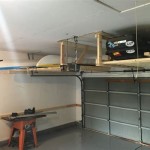How to Build Garage Storage Shelves
Garage storage shelves offer a practical solution for maximizing vertical space and organizing tools, equipment, and seasonal items. Building these shelves allows for customization based on individual needs and preferences, often at a lower cost than pre-fabricated units. This guide outlines the steps involved in constructing robust and functional garage storage shelves.
Planning and Preparation
The initial stage involves careful planning and preparation. Accurate measurements of the designated wall space are crucial for determining the overall dimensions of the shelving unit. Consider the height, width, and depth of the shelves, keeping in mind the types of items to be stored. Heavier items require more robust shelving, while lighter items allow for greater spacing between shelves.
Creating a detailed sketch or using design software can be highly beneficial in visualizing the final product and ensuring accurate material calculations. This visual aid should include the number of shelves, their respective dimensions, and the placement of support beams.
Material Selection
The choice of materials significantly impacts the shelf's durability and load-bearing capacity. Commonly used materials include plywood, oriented strand board (OSB), and dimensional lumber. Plywood offers good strength and stability, while OSB is a more budget-friendly option. Dimensional lumber, such as 2x4s and 2x6s, is used for framing and support.
Selecting appropriate fasteners is equally important. Screws provide a stronger hold than nails, particularly for load-bearing applications. Wood glue adds extra strength and stability to joints. Galvanized or stainless-steel fasteners are recommended for resistance to rust and corrosion in potentially damp garage environments.
Construction Process
Begin by constructing the vertical supports using the dimensional lumber. Cut the lumber to the desired height of the shelving unit. These supports should be securely anchored to the wall studs using appropriate fasteners and brackets, ensuring a stable and level foundation. The spacing between the supports will depend on the planned shelf width and the anticipated load.
Next, install horizontal supports between the vertical supports. These supports will form the framework for the shelves. Ensure these supports are level and securely attached to the vertical supports. The distance between the horizontal supports will determine the depth of the shelves.
Once the frame is complete, cut the shelving material (plywood, OSB, etc.) to the desired dimensions. These shelves can then be placed on top of the horizontal supports. Secure the shelves to the supports using screws and wood glue for added strength and stability. Ensure the shelves are evenly spaced and level.
Reinforcement and Finishing
For added strength and stability, consider adding diagonal bracing to the back of the shelving unit. This bracing helps to prevent racking and provides additional support for heavier loads. Plywood gussets can also be added to strengthen the joints where the vertical and horizontal supports meet.
After construction, the shelves can be finished as desired. Sanding any rough edges and applying a sealant or paint can protect the wood from moisture and improve the overall appearance. Consider using a paint or sealant specifically designed for garage environments.
Safety Considerations
Throughout the construction process, prioritize safety. Wear appropriate safety glasses and gloves to protect against splinters, dust, and potential injuries. Use caution when operating power tools and follow all manufacturer instructions. Ensure the shelving unit is securely anchored to the wall to prevent tipping or collapse. Distribute weight evenly across the shelves to avoid overloading any single section.
Customization Options
Garage storage shelves can be customized to fit specific needs. Adding drawers, cabinets, or bins can further enhance organization and storage capacity. Consider incorporating specialized features such as hooks for hanging tools or designated areas for specific items. Labeling shelves can further improve organization and accessibility.
Maintenance
Regularly inspect the shelves for any signs of wear and tear, including loose screws, damaged wood, or signs of moisture damage. Tighten loose screws and repair any damaged components promptly. Periodically clean the shelves to remove dust and debris. Maintaining the shelves will ensure their longevity and functionality.
By following these guidelines, one can construct robust and functional garage storage shelves tailored to individual needs and preferences, maximizing storage space and enhancing organization within the garage.

How To Build Shelving In A Garage Three Ways Ana White

Best Diy Garage Shelves Attached To Walls Ana White

And Easy Diy Garage Shelves Building Plans Pneumatic Addict

How To Build Garage Shelving Easy And Fast

Super Efficient 2x4 Garage Shelves Diy Storage

How To Build Diy Garage Storage Shelves Crafted Work

How To Build Garage Storage Shelves By Yourself Diy Cabinets
How To Build Garage Storage Shelves By Yourself Queen Bee Of Honey Dos

Easy Diy Garage Shelves With Free Plans Fixthisbuildthat

Diy Garage Shelves Fix This Build That
Related Posts








